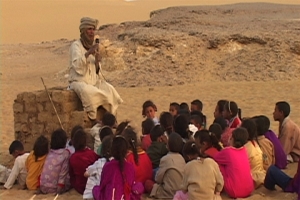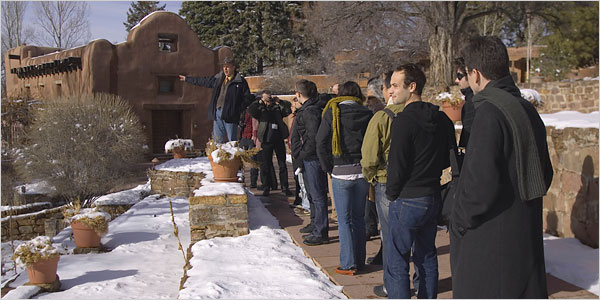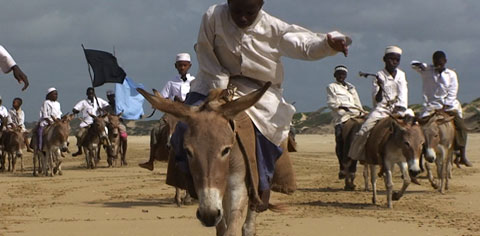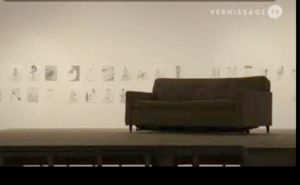 Art is often controversial and causes disagreement; provocative and causes annoyance; or offensive and causes hurt and anger. Art is supposed to do that.
Art is often controversial and causes disagreement; provocative and causes annoyance; or offensive and causes hurt and anger. Art is supposed to do that.
When an Egyptian contemporary artist, who works in Cairo, makes a controversial work, censorship can often mean violence, imprisonment, or perhaps even death. Imagine that artists surprise to be invited to participate in a biennial exhibition in America at SITE Santa Fe and then being told he could not make the work he proposed.
Wael Shawky, after spending time in New Mexico in January 2008 with 22 of the chosen “Lucky Number Seven” biennial artists and curator Lance Fung, initially reflected on the importance of mud in rural Egypt and in his own work, particularly “Frozen Nubia,” a 1996 installation featuring four mud structures.

According to Jori Finkel who documented the initial visit with artists for The New York Times (image above), Shawky “lobbied for one of the biggest spaces, so he could pitch a massive tent there, made from military fabric. He imagined covering the floor with mud. “Mud has many references,” he said. ‘In Islam we are mud. We are made of earth’.”
It is a belief shared by the Tewa culture of New Mexico, that humans come from the earth. Therefore, it is not surprising that after an extended visit to Santa Clara Pueblo at the invitation of another biennial artist Rose B. Simpson that Shawky found an affinity with the culture of the pueblo people. Simpson invited Shawky to spend an evening with her mother, well known sculptor Roxanne Swentzell. Swentzell has created sculptures critical of her own culture, of gambling and gaming.
Biennial artists were asked to create site-specific works that were temporary and in some way responded or were inspired by Santa Fe. Shawky proposed to build a stage on a platform of washing machines, televisions and appliances. On the stage, Shawky wanted to have a group of Native Americans perform a dance for the opening of the biennial. He would videotape the performance and include a responsive element from his own culture. The video would then play during the rest of the exhibition.
Shawky is a multi-media artist who explores complex modern-day sociocultural issues. Condensed into sharp images and narratives, the multilayered works are centered upon the notion of controlled entertainment. Shawky often depicts a hybridized society that is characterized by unsettling barriers and defines himself as a translator whose work reflects the current situation.
“In most of my work I have been aiming to construct a hybridized society. A system of a society in transition, a condition that is not clear, a translation. I see my role as that of the translators—this translation is heightened the closer I come to a system of an actually existing society.”
The problem with Shawky’s idea is that he wanted to translate a culture and a society that is highly sensitive to post-colonialism and outside observation.
“We should be frank. The part about the piece that I found troubling was that it was kind of a critique of a native American religious practice as he understood it about which I know very little, so correct me if I’m wrong, but that’s part of it and part of his proposal was that he would find some native American people who would perform a dance, a ritual dance, an important sacred dance to them for the opening of the piece in the biennial and I think that it showed a lack of awareness of a long and really horrifying history of white people in the United States objectifying native Americans. And it was just not something that I could personally feel comfortable with or allow the institution to support because that history is, I believe, alive and well these are not wounds that have healed, these are ongoing issues, particularly in Santa Fe,” SITE director Laura Heon told those in attendance at a symposium during the opening weekend festivities for “Luck Number 7”

(Stills from Shawky’s Telematch videos)
Yet, according to William Wells, director of the Townhouse Gallery in Cairo an affiliate curator for the biennial:
“… There was no content in the proposal put through in writing that would be appear to offensive in any way at all and then censorship took place.”
Lance Fung, curator for the biennial said he didn’t see it as inappropriate either. “I don’t care if we offend people,” Fung said via telephone from his home in San Francisco following the opening. “I stomp. Either we learn or we don’t.”
According to Fung, Heon felt that if Wael did this that the Native Americans would shut down the space.
Heon described Shawky’s practice as a political critique of Western and capitalistic culture that suffuses and overtakes indigenous culture.
“His intention was to say here’s something interesting and true. Let’s put it up,” Heon said. “The part he was missing is the earlier part that others have created these narratives. It is impossible for an outsider to represent this group of people with any hope of the reception being fair. The travesty of representation is an open would and serious, particularly to put out a critique and have it be received with any sensitivity.”
She couldn’t give him SITE’s imprimatur to make this work, so she said sorry, no way.
A meeting ensued between Fung, Joe Sanchez, director of IAIA and Simpson. Simpson told Shawky that she didn’t think he would find any Pueblo dancers who would perform the dance for him. Shawky asserts that he would have hired performers.
Simpson told me in an interview at the Hotel St. Francis in Santa Fe in July 2008, “I don’t think he’s wrong, but I don’t think it was his place to call it because it becomes judgment. It’s different when it comes from within the culture rather than an outsider.”
But Simpson agreed that Shawky was proposing to make an incredible statement. She told the symposium audience that during her visit with Shawky in January 2008:
“We reached this incredible place of consciousness about culture and associations and relationship. And Wael sent an incredible um right on proposal about essentially about the truth of what’s going on. And the thing about it is it was um a traditional dance that yes is done in hotels, yes is done for tourists and it was done on a platform of washing machines, old refrigerators things like that. The thing about that proposal is yes– it was true, it was incredible, it was positive, it was absolutely true.”
Yet, in the end Heon, Fung and Shawky were all claiming that each other had a lack of awareness.
“I have a responsibility to my community, the pueblo people, the art world, the board. I’m confident that the reception of the piece would be 180 degrees from what he expected,” Heon said.

But when prodded, Heon admitted that the reception would have been wildly mixed. “Some would say he made a really good point about materialism in this spiritual culture. Best case, Wael would be unaware. Worst case, he would be perceived as attacking a group for whom he is not invited to speak. I’m not saying his critique wouldn’t be accurate or beautiful or rigorous as a work of art, but the missing piece is the minefield of reception politics. We have to be mindful of our neighbors and the core values of our community.”
As for those rights of free speech and expression, Heon believes they come with responsibility. “You earn the right by using respect, tolerance and sensitivity.”
She went so far as to suggest that perhaps Wael was like a kid in a candy shop and given all this freedom of expression he decided to gorge on it. Which makes little sense since the artist received his MFA from the University of Pennsylvania. This wasn’t his first experience with American freedoms.
“Seriously, it’s odd, it cannot be that safe,” Shawky said. “At the end of the day, I had another part to this proposal dealing with my culture. Although I think its highly critical and criticizing the power, I felt if I made this part of Telematch as related to the Native Americans it more related to Santa Fe.”
Telematch is a series of video installations that Shawky has been working on for several years. Telematch was a German TV program from the 1980s where two villages competed against each other in medieval costumes.
“The theme of this contest its about performers, the audience, and how to create an event in order to make people fight,” Shawky explained.
Shawky’s Telematch series includes: “Telematch Sadat” about the assassination of Egyptian president Anwar Sadat. In this video there is a parade of children who jump in and kill the audience. “Telematch The Funeral” features the same group of children. “Telematch Market” involves cars driving through an empty market. “Telematch Suburb” is the film Shawky made for the 2008 SITE Santa Fe Biennial. Filmed in a suburb of Alexandria where a heavy metal band is performing and the residents of the suburb watch the film plays on the performance elements of culture. In this version, Shawky reversed the roles that he had originally intended. The “modern” entertains the “traditional” and the latter is distinctly unimpressed. There is a lack of communication. One wonders whether he had been allowed to make the version where the “traditional” entertains the “modern” if the same lack of interest would have been explored. Or what if he had taken the Native American dancers to Alexandria and had them perform for the suburban Egyptians. Would some new cultural understanding have been born?
“Telematch Suburb” and a series of drawings created by Shawky, inspired by a visit to Santa Fe’s Museum of International Folk Art, were recently on display in Egypt and Jordan. Shawky saw the hybrid history of Santa Fe retold through the folk art. Evident to him was how Native American and Spanish identities were condensed into simple, readable forms.
“The drawings are of all these small toys,” Shawky said. “They are performers for identities but at the same time they are clichés.”
The installation Shawky created for the biennial (image below) was about many cultures watching each other. The stage in the middle of the room was designed for the audience to watch the videos, but as they watch, the audience was seen as a performer watched by those above and around.

Off to one corner sat a lone washing machine, a symbol for Shawky of the idea of cleansing history.
Fung said of Shawky’s work: “Wael addresses culture in general and miscommunication. His plasma screen is on the ground, the washing machine washes away cultural diversity.”
“If it’s controversial, deal with it. Educate people. Figure it out,” Fung said.
Wael was drawing parallels between his own Muslim religion and the religion and spirituality of the Tewa people. He was perhaps using a disenfranchised group, suffering from what Simpson called “post colonial stress disorder” to comment on his own religion, his own culture in a way that he felt was safe. One that would not involve death and he was dumbfounded to be censored.
If he had made the work, Simpson said she would have felt disgusted because someone else from the outside was pointing fingers at her culture.
“No Wael you don’t understand the beautiful integrity, that hope, that beauty, that respect that gives us hope that we can make things better. It feels like a shaming,” she said.
Yet Simpson acknowledged “a lot of people don’t understand his culture from this area.” “Him telling his story to us here is a lot more effective to help us see our own issues.”
But he was supposed to tell his story and react to the setting, the city, the culture of Santa Fe. It seems to me that this is what Wael Shawky was trying to do–he was trying to tell his story using a reference to which we could relate. A reference to which he found an affinity and something he thought might help tell his story. And perhaps we are all unaware and disconnected, so focused on our own story that we fail to understand or try to hear, try to communicate.
“He’s the big white elephant in the corner,” Simpson said of Shawky. “He brings up a lot of issues. I can be honest with him without feeling like I’m a bad guy or he’s the bad guy.”
As for her art, Simpson said that her experience as a Biennial artist at SITE Santa Fe and working with Shawky has made her question the Indian art world, as we know it. She has enrolled in an MFA program in ceramics at the Rhode Island School of Design.
“I appreciate the sense of connection to home. The biggest thing is that we are all indigenous to the earth. The sense of place becomes bigger. Your family becomes bigger. You have more relatives.”
Censorship is a powerful term. No one wants to be accused of suppressing the expression of another. In the art world, museums, galleries and nonprofit spaces, magazines and newspaper are about freedom of expression. Our constitution prohibits the government from abridging the freedom of speech. But there is no law prohibiting a public or private organization from suppressing the expression of one artist, particularly when there is concern that the expression would be offensive to their donors, their community or the indigenous people they have failed to include in their exhibits since their inception.
Heon felt that censor was too big a word to use to describe what happened with Shawky. But by definition, censorship is the suppression of things deemed objectionable on moral, political or other grounds.
In this case, it was suppression of an idea deemed objectionable on cultural grounds. It was censorship.
Leave a comment